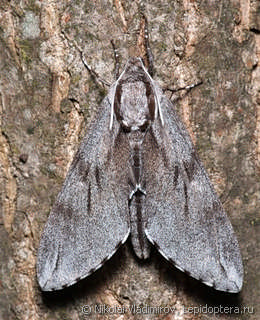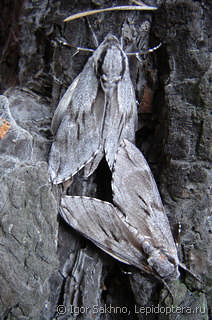Hyloicus pinastri

Taxonomy
class Insecta
Species name(s)
Hyloicus pinastri (Linnaeus, 1758) = Sphinx piceae Gleditsch, 1775 = Sphinx saniptri Strecker, 1876 = Hyloicus asiaticus Butler, 1875 = fasciata Lampa, 1885 = brunnea Spuler, 1903 = grisea (Tutt, 1904) = grisea-distincta (Tutt, 1904) = grisea-mediopuncta (Tutt, 1904) = grisea-transversa (Tutt, 1904) = typica-virgata (Tutt, 1904) = unicolor (Tutt, 1904) = albicans (Austaut, 1907) = fuliginosa Lambillion, 1907 = ferrea Closs, 1920 = vittata (Closs, 1920) = minor Stephan, 1924 = rubida (Cabeau, 1925) = semilugens (Andreas, 1925) = albescens (Cockayne, 1926) = albicolor (Cockayne, 1926) = stehri Stephan, 1926 = Hyloicus pinastri cenisius Jordan, 1931 = Hyloicus pinastri medialis Jordan, 1931 = nigrescens (Lempke, 1959) = cingulata (Lempke, 1964) = Hyloicus pinastri euximus Derzhavets, 1979 = selon (de Freina & Witt, 1987) = Sphinx pinastri (Linnaeus, 1758). [9, 10]
Pine Hawk-moth.
urn:lsid:insecta.pro:taxonomy:2856
Expansion
This species marks on the maps: 7.
Zoogeographical regions
Palaearctic.
Russia regions
#1. Kaliningradsky*; #2. Kolsky; #3. Karelsky; #4. Evropeisky Severo-Zapadny; #6. Evropeisky Severo-Vostochny; #7. Evropeisky yuzhno-tayozhny; #8. Evropeisky Tsentralny; #9. Evropeisky Tsentralno-Chernozyomny; #10. Sredne-Volzhsky; #11. Volgo-Donsky; #15. Severo-Uralsky; #16. Sredne-Uralsky; #17. Yuzhno-Uralsky.
* An asterisk denotes a region for which the species is listed as an migrant or information that requires additional checking.
Forewing length
35—40 mm.
Primary colors
Brown/Gray/Black.
Flight time
| January | February | March | April | May | June | July | August | September | October | November | December |
Larva lifespan
| January | February | March | April | May | June | July | August | September | October | November | December |

Detailed information with references
Taxonomy, synonyms and combinations
Distribution
Imago Habitus and Differences from alike species
General info about Imago
Imago lifespan
General info about Larva
Larva food plants / other food objects
Larva lifespan
Subspecies of Hyloicus pinastri
- Sphinx pinastri arestus Jordan, 1931. [187]
- H. p. cenisius Jordan, 1931. [187]
- H. p. massiliensis Jordan, 1931. [187]
- H. p. maurorum Jordan, 1931. [187]
- H. p. medialis Jordan, 1931. [187]
- H. p. morio Rothschild & Jordan, 1903. [187]
Authors
Initial species uploading to the site: Peter Khramov.
Text data: Peter Khramov.
The species characteristics formalization: Peter Khramov.
References
- [1] O. Karsholt, J. Razowski (eds.), 1996. The Lepidoptera of Europe: a distributional checklist
- [3] Каталог чешуекрылых (Lepidoptera) России. Под ред. С. Ю. Синёва. СПб.; М.: Товарищество научных изданий КМК, 2008
- [5] Райххолф-Рим Х. Бабочки. М.: Астрель, 2002
- [9] Tree of Life (funet.fi), 2012
- [10] de Jong, Y.S.D.M. (ed.) (2011) Fauna Europaea version 2.4 (faunaeur.org)
- [28] Moths and Butterflies of Europe and North Africa (leps.it), 2012
- [187] Species 2000, http://www.sp2000.org
Comments
Note: you should have a Insecta.pro account to upload new topics and comments. Please, create an account or log in to add comments
Hyloicus pinastri photos


































































All the photos of the species in large size
Please, create an account or log in to upload your photo